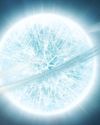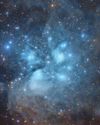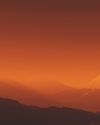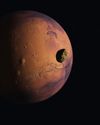Try GOLD - Free
FINDING AND DEFINING EXOMOONS
All About Space
|Issue 127
As our catalogue of exoplanets grows, the hunt is on for moons around distant worlds

Astronomers may have finally discovered a moon orbiting around a planet outside our Solar System. The development could have important implications for our understanding of how planetary systems evolve, as well as indicating how typical the planets of our Solar System are. Since the first discovery of planets around stars other than the Sun was made in the early 1990s, our catalogue of planets outside the Solar System has burgeoned, now containing over 4,000 confirmed worlds. One of the most important aspects of our investigation of these extrasolar planets – or exoplanets – is the assessment of how similar or diverse they are in comparison to the planets of the Solar System.
It’s unsurprising given how Earth’s own Moon has dominated our imagination and played a vital role in both astronomy and humanity’s exploration of space that the hunt for moons around these extrasolar worlds – or exomoons – is a subject of intense interest. This is compounded by the fact that moons are abundant in the Solar System, with an average of 20 moons for each planet. And we have no reason to believe that our planetary system is unique in this respect, making the elusive nature of exomoons confusing and frustrating.
This story is from the Issue 127 edition of All About Space.
Subscribe to Magzter GOLD to access thousands of curated premium stories, and 10,000+ magazines and newspapers.
Already a subscriber? Sign In
MORE STORIES FROM All About Space

All About Space UK
MYSTERIES OF THE UNI WHERE ARE ALL THE SPIRAL GALAXIES?
There are far fewer spiral galaxies than elliptical ones in the Supergalactic Plane, and scientists are keen to discover why
7 mins
Issue 161

All About Space UK
ZOMBIE STARS
+10 OTHER TERRIFYING SPACE OBJECTS
8 mins
Issue 161

All About Space UK
HOW TO BEAT LIGHT POLLUTION
Thought it was impossible to observe the wonders of the night sky from towns and cities? Think again. Follow our tips and tricks on successfully observing through sky glow
2 mins
Issue 161

All About Space UK
15 STUNNING STAR CLUSTERS
These beautiful stellar groupings are spattered across the cosmos
8 mins
Issue 161

All About Space UK
Eileen Collins "It was a difficult mission...we were the first to see Mir"
Having served as both the first female pilot and first female commander of NASA's Space Shuttle, Collins boosted the involvement of women in space exploration to a whole new level
9 mins
Issue 161

All About Space UK
MARS LEAKS FASTER WHEN IT'S CLOSER TO THE SUN
The Red Planet has lost enough water to space to form a global ocean hundreds of kilometres deep
2 mins
Issue 161

All About Space UK
FUTURE TECH KANKOH-MARU
This ambitious reusable spacecraft will be capable of taking 50 people to and from orbit
2 mins
Issue 161

All About Space UK
THE FINAL FRONTIER
Beyond the reach of the Sun is a fascinating region of the cosmos that were only just beginning to explore
8 mins
Issue 161

All About Space UK
A long-lost moon could explain Mars' weird shape and extreme terrain
A long-lost moon could explain why Mars is so different from the other rocky planets in the Solar System. Today Mars has two tiny moons.
2 mins
Issue 161

All About Space UK
A sprinkling of cosmic dust may have helped kick-start life on Earth
Cosmic dust may have helped kick-start life on Earth. New findings challenge a widely held assumption that this wasn't a plausible explanation.
3 mins
Issue 161
Translate
Change font size
